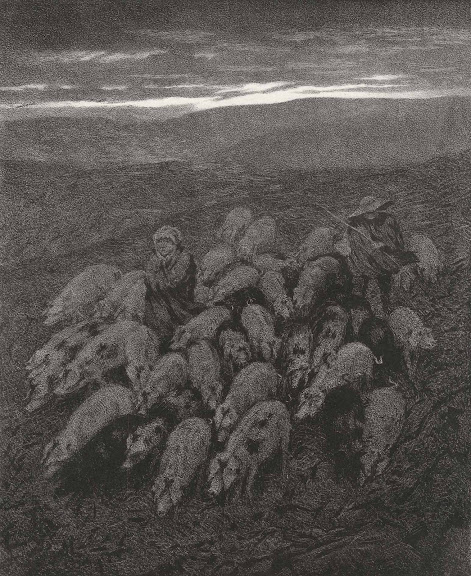Charles Émile Jacque (1813–1894)
“Road at the Edge of a Wood” (aka “Lisière
de Bois”), 1846, signed and dated in the plate.
Etching, drypoint and aquatint on laid
paper backed with a support sheet.
Size: (support sheet) 26.7 x 34.2 cm; (sheet)
16.5 x 20.2 cm; (plate [soft]) 9.6 x 13.4 cm; (image borderline) 7.4
x 11.5 cm.
Inscribed in plate at lower right: “Ch. Jacque. 1846. Xbre".
State ii (of ii)
Guiffrey 124 (J-J Guiffrey 1866, “L'Oeuvre
de Charles Jacque: catalogue de ses eaux-fortes et pointes seches”, Paris, p. 74,
cat. no. 5); IFF 180 (Jean Adhémar & Jacques Lethève 1954, “Inventaire du
Fonds Français: Bibliothèque Nationale”, Paris, Département des Estampes, cat.
no. 180); Beraldi 124 (Henri Béraldi 1885–1892, “Les Graveurs du XIXe Siècle:
Guide de l'Amateur d'Estampes Modernes”, vol. VIII, Paris, Librairie L.
Conquet, p. 184, cat. no. 124 [https://archive.org/details/lesgraveursdu19e08berauoft/page/184/mode/1up]).
Guiffrey (1866) offers the following
description of this print: transl.] “Edge of wood. A road on the edge of a wood
sinks in turning to the left. On the right, in the foreground, three or four
large trees dominate the coppice; at the foot of one of them a man is seated.
Grey sky” (p. 74).
The British Museum and the Art Institute of
Chicago offer descriptions of this print:
https://www.britishmuseum.org/collection/object/P_1889-0608-177;
https://www.artic.edu/artworks/45709/road-at-the-edge-of-a-wood.
Condition: a richly inked impression with
margins laid onto a support sheet of archival (millennium quality) washi paper.
The sheet is in a good condition with no significant stains or foxing, but there
are signs of erasure of collector’s marks in the lower margin and pale toning.
I am selling this graphically strong and poetically moody etching by one of the luminaries of the Barbizon
School for AU$256 (currently US$183.57/EUR171.26/GBP145.89 at the time of
posting this print) including postage and handling to anywhere in the world,
but not (of course) any import duties/taxes imposed by some countries.
If you are interested in purchasing this very
beautiful study of a forest with a resting traveller—presumably the forest of Fontainebleau—please contact me
(oz_jim@printsandprinciples.com) and I will send you a PayPal invoice to make
the payment easy.
This print has been sold



















































